Wogan went to 3 undergrad colleges, MSW at Cal Berkeley, Special Ed at SFSU, Urban Ed Leadership at CSUEB, Clinical Psych at CSPP, practicum at UNC, research w 東京大学

Wogan went to 3 undergrad colleges, MSW at Cal Berkeley, Special Ed at SFSU, Urban Ed Leadership at CSUEB, Clinical Psych at CSPP, practicum at UNC, research w 東京大学


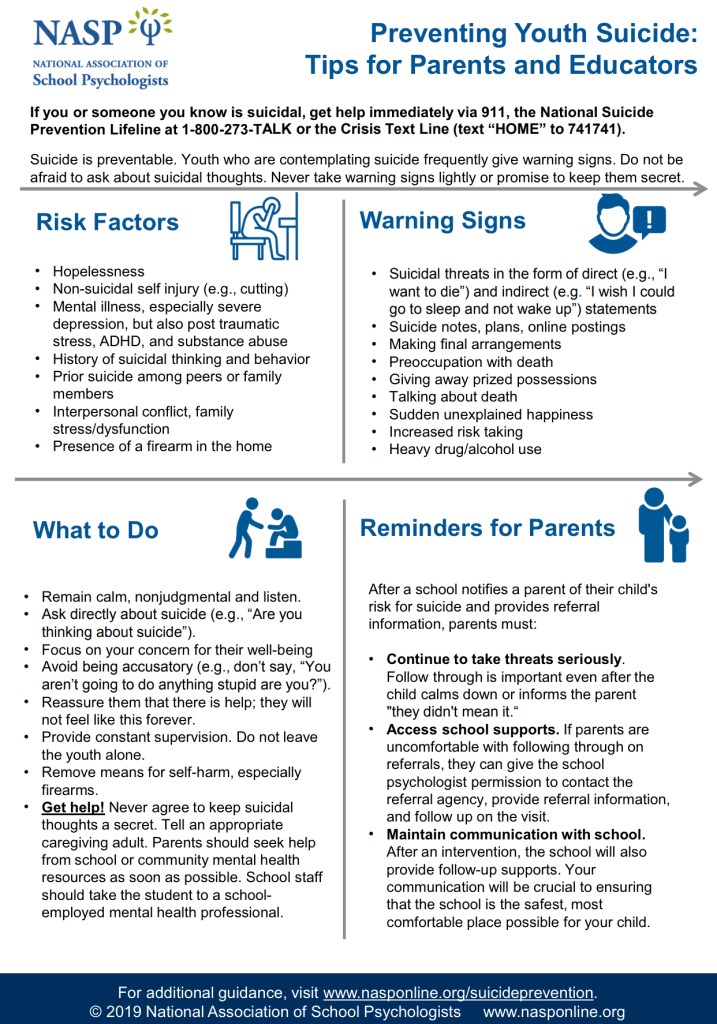






Creating inviting and welcoming school environments is essential for all school communities. Schools throughout the world recognize the importance of meaningful engagement with parents and guardians from diverse backgrounds. Most schools have grown beyond conventional school parent engagement strategies focused on “getting parents through the school door.” “Family” must be broadly defined by schools as they develop plans for meaningful parent engagement; the “traditional family” is not the norm (Pew Research, 2014). At the same time, parents and guardians from diverse backgrounds have expressed concern that they do not feel welcome or comfortable in many school settings. Amid changing demographics and advances in technology, schools have opportunities to connect with parents and guardians in ways that did not exist ten years ago. This article is an invitation to share strategies, reflections, and innovative programs to increase parent engagement, with emphasis on engaging parents from diverse backgrounds.
Why family involvement in schools? Teachers and staff understand the importance of working with parents in positive ways, and to involving the community to increase student success. Parents want know that their children are being challenged academically in caring, safe and supportive environments. Students want to do well in school. They need guidance, support and care from their teachers, parents and family members, and the community. Over 25 years of work and research in public education and public health tells us that student wellness and academic success is inextricably related to parent engagement in schools (Wogan, Browne 2017). The more actively involved parents and guardians are, the more successful students are, academically and socially (Comer, 2009). When parents and guardians are actively involved with their child’s education, there is a positive impact on achievement, attendance, and connectedness with the school community (Canada, 2015). Coordinated School Health, school beautification, and cooking together with guardians from diverse cultures increases a sense of belonging to a welcoming school community. School districts have made dedicated efforts to engage fathers and male guardians in school events. Adolescence is starting earlier and lasting longer (Steinberg, 2015). Many parents report feeling unprepared to support teenagers facing a world that is changing rapidly. Denise Pope’s Challenge Success skillfully describes the demands and pressures that students in today’s world face. Rising rates of teen suicide and other behavioral health concerns make it essential for schools to engage parents, grandparents, guardians and caregivers to work together to improve child and teenage wellness.

What are obstacles and barriers to parent engagement with families of color? Research reflects that partnerships between parents and schools tend to decrease as children get older and that affluent communities have more frequent “through-the-school doors” family engagement than economically disadvantaged communities. More recent data reflects that parents and families are actually actively involved and invested in education as well as with events and activities take place in the community, i.e. at churches, mosques, and temples. Schools in high-poverty communities more frequently contact parent about problems and difficulties than positive accomplishments. Single parents, parents who work more than one job, parents living far from school, and fathers are generally less involved in school committees and events. This is sometimes erroneously interpreted as not “caring about,” prioritizing or valuing education. The backgrounds and ethnicities of staff members may not reflect that of the community. Additionally, trust and feelings of mutual respect may be lacking. Parents sometimes report that it feels like “two steps forward and one step back.” Parents in predominantly wealthy neighborhoods have objected to matriculation (feeder pattern) policies that place students in lower-income schools with higher numbers of students of color. Schools are working to build a sense of community across diverse cultures.
Educators recognize the importance of parents being involved at school, but struggle to develop sustainable plans for meaningful and consistent engagement, particularly among families of color, LGBTQ+ families, and recent immigrants.
Almost all teachers and administrators want to involve families in schools, but many have not been trained or prepared to build positive and productive partnerships with families from diverse cultures, backgrounds and ethnicities. School districts and organizations such as California Association for Bilingual Education (CABE) are paying increasing attention to the academic needs of English Language Learners (ELL). Many recent immigrants have experienced hardships and trauma on their journey to the United States, however, few school districts uniformly inquire about trauma or life stressors that children, parents and relatives have experienced. At the same time, schools do not regularly inquire about food stability or stable housing. The impact of trauma on learning is increasingly recognized and researched. The impact of poverty and neglect, however, is less frequently discussed or in the media (See LinkedIn posts by James Wogan, Ron Powell, UCSF). School social workers and other professionals have implemented model programs to support the physical, social, emotional, behavioral and academic needs of recent immigrants, and specialized programs that meet the unique educational needs of foster youth, homeless children and families. Ruby Payne, Marcus Foster, Jeffrey Canada, James Comer, Jonathan Kozol, Joy Dryfoos, Glen Singleton, Paulo Freire, Stephanie Graham, Sálvador Minunchín, Marianne Pennekamp, and many others have raised consciousness, shined a light on “implicit bias,” institutional practices, and developed positive solutions for working together with parents and guardians from diverse backgrounds. Read the following statement and describe your team’s thoughts and reactions. “All families care about their children and want them to succeed, even if they can’t attend many (if any) events at school. “ What percent of your immediate colleagues agree with this statement? What strategies and innovative programs for partnerships with parents have you tried or attempted?
Six (6) types of family involvement in schools:
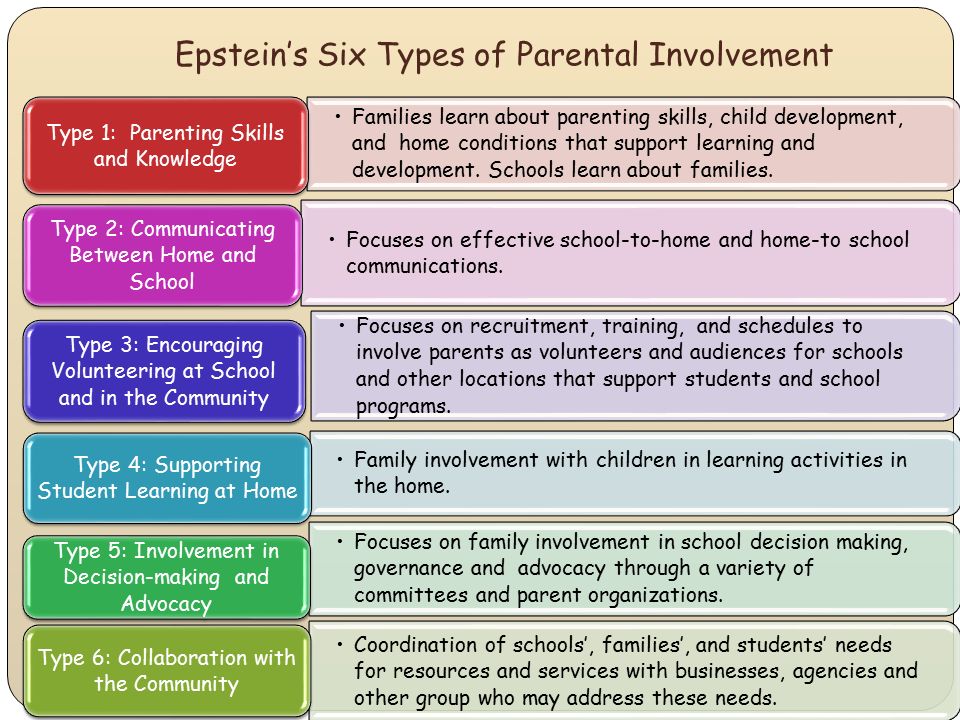
While at Johns Hopkins University, Joyce Epstein identified six (6) types of family involvement: 1) Parenting: Helping families establish home environments to support children as learners. 2) Communications: The use of effective forms for school-to-home- and home-to-school communications. 3) Volunteering: The recruitment and organization of the school’s volunteer program. 4) Learning at Home: Helping families assist their children with homework and recognizing other learning at home opportunities 5) Decision making: Including parents, students, and community members in the school decision making process. 6) Collaborating with the Community: The identification and integration of resources and services from the community.
What does it mean to be a “parent-friendly” school? A parent gave the following examples of a school being “parent friendly.” She said, “It makes me feel good when school staff are friendly and professional when we (parents) are there.” It’s good to be friendly, but not informal, especially with greetings. An African-American grandmother suggested that we address parents by their last name such as Ms. Mrs. Mr. Dr., and in respectful tone. It’s helpful to see diverse cultures represented and welcomed. Please be polite on the phone, and speak slowly if needed. Proactive communication in multiple languages always helps. Parents appreciate a quick reply to emails, but “don’t assume that I check my email and text every 5 minutes.” Parent feedback and suggestions should be requested, verbally.
Parents Feel Welcome When… they are greeted in a friendly manner. When they are treated with respect. When people introduce them to other school personnel who are nearby. When they feel the school genuinely has their child’s best interests at heart. When school show appreciation for diversity. When school personnel reach out to them through telephone calls, text, email, and notes. When the school provides opportunities for them to connect with other parents.
Indicators of Respect for Parents: Being greeted and spoken to politely “even when you’re there for the 10th time.” Being recognized and acknowledged by school personnel. Being thanked for visiting the school and for taking an interest their child’s education. Schools having an open-door policy. The principal and staff members taking the time to speak with parents. School personnel trying to be helpful, even if the parent’s question or concern is outside the scope of their position.
Unwelcoming School Experiences for Parents: Being ignored by school personnel when they arrive at the school. Arriving at scheduled school appointments and being made to wait for an hour. Being told “you should have called first” when they drop by the school unannounced. Being asked to “sign in” before greeting, saying “hello.” Being asked name, and child’s name, after volunteering at school for more than two years. Being told that they cannot observe their child’s class without a scheduled appointment Informal “my new BFF” IKR LOL Interactions
Good News! When schools develop and implement school-wide and classroom parent engagement practices such as Positive Behavior Intervention and Support (PBIS), barriers to family involvement can be eliminated, and partnerships with parents can be strengthened. Parent and family engagement can be strengthened at all schools, however, no one role group can do it alone. Parents and guardians complain that school personnel use too much jargon, SST, MTSS, PBIS, etc, but they can feel it when teachers and administrators make parent engagement a priority and involve people across role groups with build positive relationships with students’ families and extended families.
Reflections through the lens of equity: School personnel sometimes assume that parents from culturally diverse backgrounds need “parenting skills” to overcome their child’s “lack of engagement” in class. Deficit-oriented approaches been shown to generate resistance among African-American and Latino parents (Olivos, 2004; Sobel & Kuglar, 2007). Parent Empowerment: Open dialogue, listening to concerns, and facilitating conversation among parents has been shown to be an effective strategy when incorporated into larger family engagement plans. Parent Feedback: According to some parents, including parents of color and LGBTQ parents, school personnel tend to overuse Power Point PPT presentations, screens, poster paper and sticker during meetings. Parents of color acknowledge that it’s essential to communicate information, but report that these tools can be counter-productive, serving to put distance between the presenters and the participants. Parents would like opportunities to build community and talk with each other and to digest information collectively as well as individually.
Latino families are involved and invested in their children’s education, but often say that they must feel trust before deciding which events to attend at school, especially since the election of Donald Trump (2016). Latino families may be less visibly involved in their children’s school. Lack of visibility has been judged and interpreted as indifference, lack of concern, or “different values.” Conversations, stakeholder meetings, and research shows this not to be true. Too often, school personnel interact with a limited number of Latino parents (the same parents have been on committees for years). Fortunately, schools are beginning to focus on building relationships with families from diverse backgrounds, rather than a one-size-fits-all approaches. Rather than blindly setting goals to “get them through the door,” schools need a clear plan for meaningful participation once parents and guardians get there. Parents appreciate knowing how they can be actively involved from home.
 Sample Best Practices for Parent Engagement through the Lens of Equity: Welcoming letters in multiple languages. Handouts for parents regarding parent involvement, supporting education at home, and tips for navigating school and school district system. Calendars and lunch menus with invitations for parent engagement. Training for teachers and staff regarding culturally proficient meetings with parents and guardians, i.e. parent/teacher conferences. Proactive positive communications with parents and guardians, including parents of students who enroll mid year. Conferences with every parent or guardian at least once a year, with follow-ups as needed. Language translators assist families as needed. Weekly or monthly folders of student work are sent home and reviewed, parent and guardian comments returned to teacher. Student ambassadors encourage and assist families to learn about the myriad of ways that families can connect with school. School lunch menus with tips for parents re Healthy Eating, Mindfulness, Exercise, and Sleep. Parent and student pick-up of report card, with conferences on improving grades. School calendar with schedule or parent involvement activities, notices, memos, phone calls, newsletters, and other communications. Clear information on choosing courses, access to programs, and activities at schools and printed materials on all school policies, programs reforms, and transitions. If this reads like a list, it’s because it’s from a presentation earlier this year (Wogan, Browne 2017).
Sample Best Practices for Parent Engagement through the Lens of Equity: Welcoming letters in multiple languages. Handouts for parents regarding parent involvement, supporting education at home, and tips for navigating school and school district system. Calendars and lunch menus with invitations for parent engagement. Training for teachers and staff regarding culturally proficient meetings with parents and guardians, i.e. parent/teacher conferences. Proactive positive communications with parents and guardians, including parents of students who enroll mid year. Conferences with every parent or guardian at least once a year, with follow-ups as needed. Language translators assist families as needed. Weekly or monthly folders of student work are sent home and reviewed, parent and guardian comments returned to teacher. Student ambassadors encourage and assist families to learn about the myriad of ways that families can connect with school. School lunch menus with tips for parents re Healthy Eating, Mindfulness, Exercise, and Sleep. Parent and student pick-up of report card, with conferences on improving grades. School calendar with schedule or parent involvement activities, notices, memos, phone calls, newsletters, and other communications. Clear information on choosing courses, access to programs, and activities at schools and printed materials on all school policies, programs reforms, and transitions. If this reads like a list, it’s because it’s from a presentation earlier this year (Wogan, Browne 2017).
Parent Engagement: Innovative Practice: In 2017, in an effort to develop deeper and more meaningful connections with parents, my school district began co-location of district personnel (resource worker, social worker, parent liaison) at a community agency. We established parent-to-parent support meetings and facilitated parent and guardian connections with each other at a local nonprofit community agency. When it comes to “co-location and collaboration,” school districts interpret this to mean “they come to us” and work out of our Wellness Centers, with services coordinated by the School Coordinated Care Team, or some other service-delivery and tracking system. We know that parent support and education as a key factor to prevent youth from becoming involved in juvenile crime. The 180° Program – offers youth and family support, gang prevention, weapon suppression, and crime reduction support services. Funding is awarded from “asset and property seizure and forfeiture.” As an innovative approach to engage parents and guardians, we co-located a School Social Worker and three part-time bilingual resource workers (classified positions) at the community. The three resource workers are mothers, with children who attended local schools, trained to support families to access resources and navigate public agencies, such as public education and health care. Additionally, teachers are trained in “Mental Health First Aid” and Trauma-Informed Practices,” increasing capacity and comfort to discuss behavioral health concerns with parents, and recommend that families consider seeking professional services. We started by listening. Informational meetings were valuable, but we needed to create space to request feedback, input, and suggestions. This inchoate program has been well received, especially among parents of color. Go to them, establish trust, meet parents “where they are.” Through parent education and empowerment, the goal of the 180 program is to interrupt the school-to-prison pipeline, prevent commercially sexual sexual of children (CSEC) and involvement of minors in crime and gangs.
 Technology and Apps to Connect with Parents and Guardians: We surveyed teachers, parents, foster parents, and students to inquire what apps and technology are currently being used to strength home-to-school communication. The following is the list that we compiled. Class Dojo – Pinterest – Remind – Instagram – Twitter – Google Classroom – Ringya (group projects) – Kids A-Z – Collaborize Classroom – Live School – Parent Class Messenger – Power School Mobile – Edmodo – School Rack – Seesaw School Circle – Teacher Kit – Word Press (blogging). This list is by no means exhaustive, and we have no fiscal relationship with any of these apps or providers. Some school districts are still developing committees to provide guidelines for schools regarding technology and communications. Meanwhile, teachers and staff are out in front, using technology and spreading the word about what works. Schools are mindful that the digital-divide has not not been closed and that many homes do not have access to the internet. Foster parents, homeless parents, and the caregivers of students who enroll during the course of the school year said that they are often left behind when it comes to home-to-school communications. As a solution, parents and caregivers have asked that they be added to apps, digital communications, and mailing lists for newsletters and print communications.
Technology and Apps to Connect with Parents and Guardians: We surveyed teachers, parents, foster parents, and students to inquire what apps and technology are currently being used to strength home-to-school communication. The following is the list that we compiled. Class Dojo – Pinterest – Remind – Instagram – Twitter – Google Classroom – Ringya (group projects) – Kids A-Z – Collaborize Classroom – Live School – Parent Class Messenger – Power School Mobile – Edmodo – School Rack – Seesaw School Circle – Teacher Kit – Word Press (blogging). This list is by no means exhaustive, and we have no fiscal relationship with any of these apps or providers. Some school districts are still developing committees to provide guidelines for schools regarding technology and communications. Meanwhile, teachers and staff are out in front, using technology and spreading the word about what works. Schools are mindful that the digital-divide has not not been closed and that many homes do not have access to the internet. Foster parents, homeless parents, and the caregivers of students who enroll during the course of the school year said that they are often left behind when it comes to home-to-school communications. As a solution, parents and caregivers have asked that they be added to apps, digital communications, and mailing lists for newsletters and print communications.
Guidelines for Communicating with parents through apps, email, texts, blogs, twitter, social media: James Jedai Wogan developed the following guidelines for communicating with parents and guardians: Just the facts: Tone and emotion can be difficult gauge via text. Use clear and concise language. Avoid jokes and sarcasm. Avoid emojies b/c may not come through as intended. they don’t through on all phones. Positive communication should outweigh concerns or corrections: 80% positive vs. 20% corrections or directions. View communications through the “lens of equity,” cultural competence, and LGBTQ-sensitive interactions. Many students have two mothers, two fathers, and some have three of each. To be sensitive to transgender students, it is increasingly ok to use the pronoun “them” and “they” vs. “his / her” binary language. Protect privacy. Don’t use the names of other students in communications. Only post photos with signed permission on file. What other guidelines do you suggest? Please send suggestions to: jameswogan@yahoo.com.
Model Parent Engagement Programs: California PTA: The School Smarts Parent Engagement Program is a model for creating meaningful and diverse parent involvement. It brings parents from all backgrounds together in support of their common interest: helping their children and schools to succeed. School Smarts is proven to: Foster parent engagement in schools. Support parents as children’s first teachers. Develop future parent leaders. Encourage parents to advocate for a complete and quality education that includes the arts. http://www.capta.org. Local school board member Linda Mayo is an awarded champion for parent engagement, parent leadership, and PTA’s. The Parent Institute for Quality Education (PIQE) aims to increase parents’ knowledge and skills to support the academic achievement of their children. PIQE developed a model for increasing parent involvement in K–12 schools where parent participation has been difficult to achieve. PIQE uses informal education techniques that have been promoted by Paulo Freire and others dedicated to promoting social change, such as using dialogue to build community and social capital, situating educational activity in the lived experience of participants, and raising participants’ consciousness about their situations and their own power to take informed action. http://www.pique.org
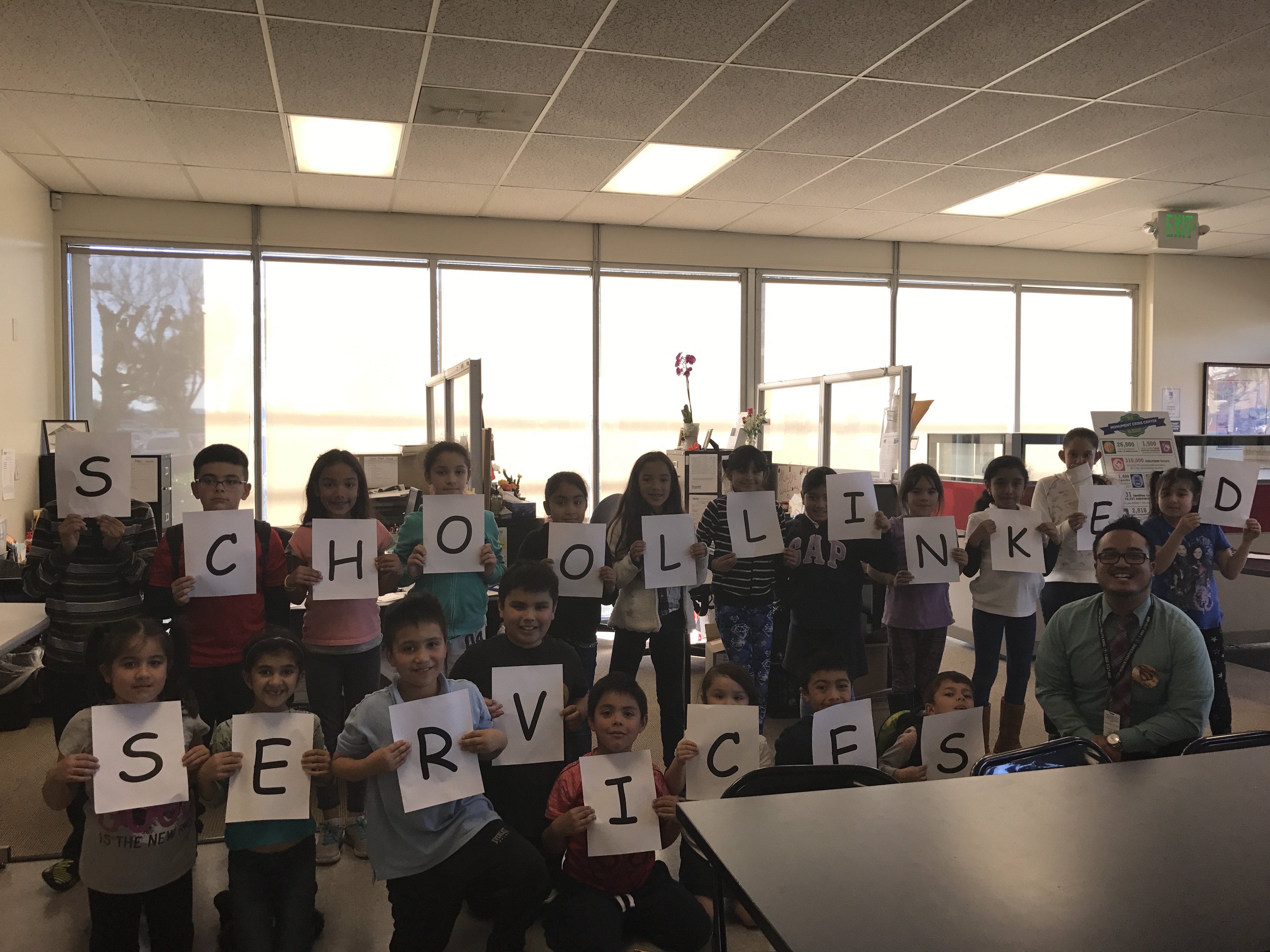
Recipe for success: Set the table: Begin with a shared vision for parent engagement. Establish a Framework for Family Engagement. Insist on transparent decision making. Bring diverse interests together. Bring people together to review data, identify student / community needs / gaps in services. Involve student and parent voice. Define goals positively, rather than the absence of problems. Reflect openly about implicit bias and assumptions. View resources as instruments of action, not personal possessions. Involve teachers, and other key stakeholders. Define performance measures and outcome measures. Consider realigning positions and programs to increase parent involvement. Superintendents and school principals: one cup of accountability, two cups of support. Stir vigorously.
Acknowledgment: I co-presented a webinar with Mildred Browne, Ed.D. with CalStat. I would like to thank Dr. Browne for her guidance and support.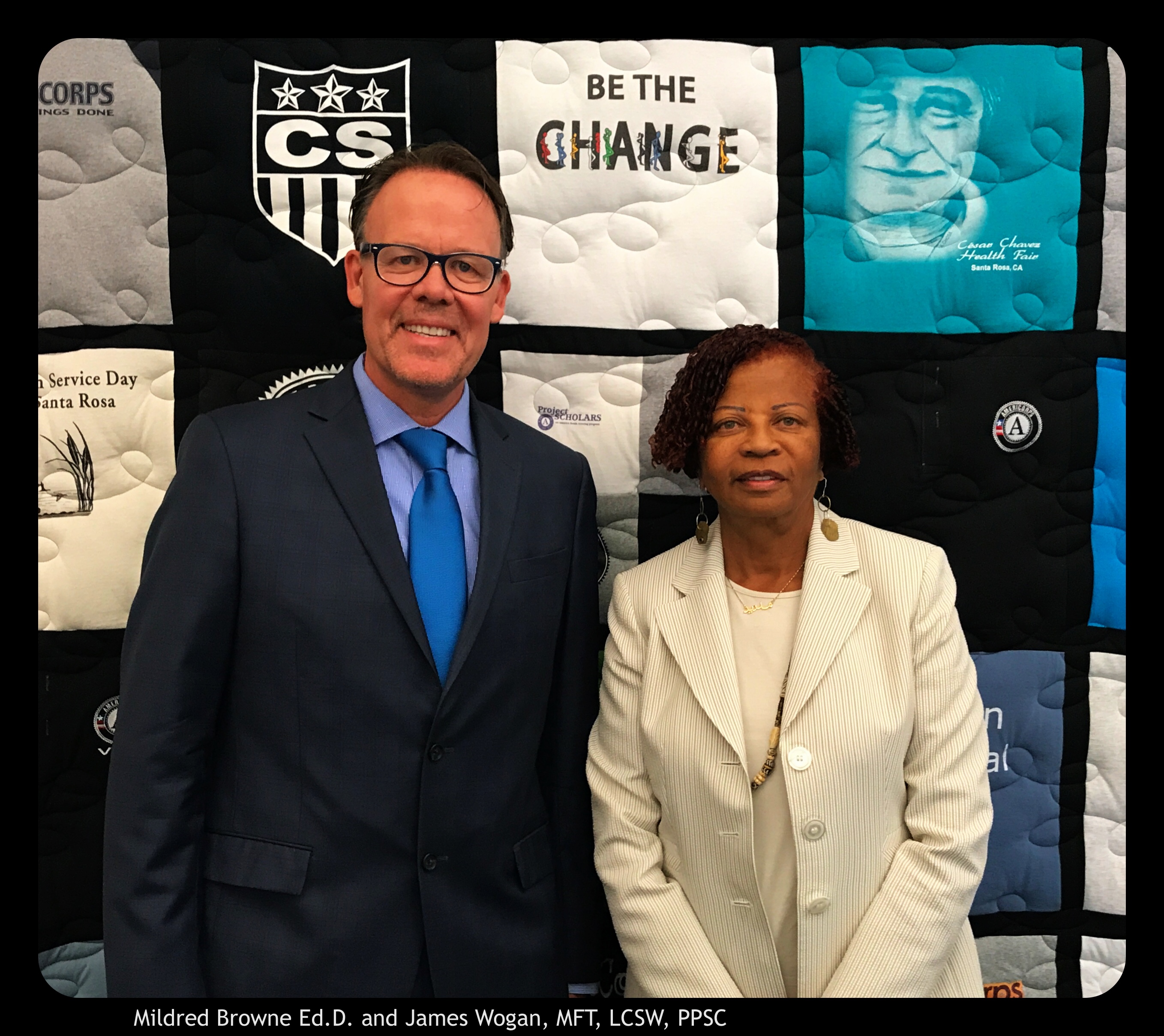
Dr. Browne and I welcome comments and suggestions, resources, and links.
James Wogan
James Wogan, LCSW
5845 College Ave # 8. Oakland, CA 94618 jameswogan@yahoo.com
Imessage: 925.250.5500
My friend did healing ceremony w water 💦; w high priestess from Bali. Her health and mental health improved dramatically.
https://www.baliwellnessretreat.com/excursions-activities/the-balinese-water-purification-ceremony/
San José State University School of Social Work, in partnership with the California Association of School Social Workers (CASSW), offered a webinar / professional development workshop focused on Student Support Teams. Authors and co-presenters Howard Blonsky and James Wogan focused on the facilitator role of School Social Workers at three (3) types of Student
Support Teams: the School Coordinated Care Team, the Student Success Team (SST), and the Student Attendance Review Team (SART). Link to slide deck and video recording of webinar embedded.

Moses Moody reflects on high school poem “He Beat the Streets.”
Like a rose blooming through the cracks in concrete, some young people manage to blossom and thrive despite facing systemic barriers and adversities. For those growing up in historically marginalized communities of color, the odds are stacked against them from birth – underfunded schools, lack of resources, generational poverty, racial discrimination. It can feel like an impenetrable concrete jungle.
However, with the support of caring mentors, coaches, and extended family, the trajectory can shift. A dedicated school social worker, for example, can be a lifeline – ensuring basic needs are met, connecting families to services, and bearing witness to students’ self-determination.
Have you ever tried to criticize yourself out of criticizing yourself? “There you go again criticizing yourself you fool. No wait, I criticized myself for criticizing myself.” Ohhh so Bob Marley and John Lennon were right this whole time? I knew it.
Lasting change doesn’t happen through negativity. In fact, it happens in spite of negativity.
One love.

“Where Should We Begin?” A game of stories.
I recommend the couples cards by my favorite couples’ therapist, Esther Perel.
Esp. good for a road trip.

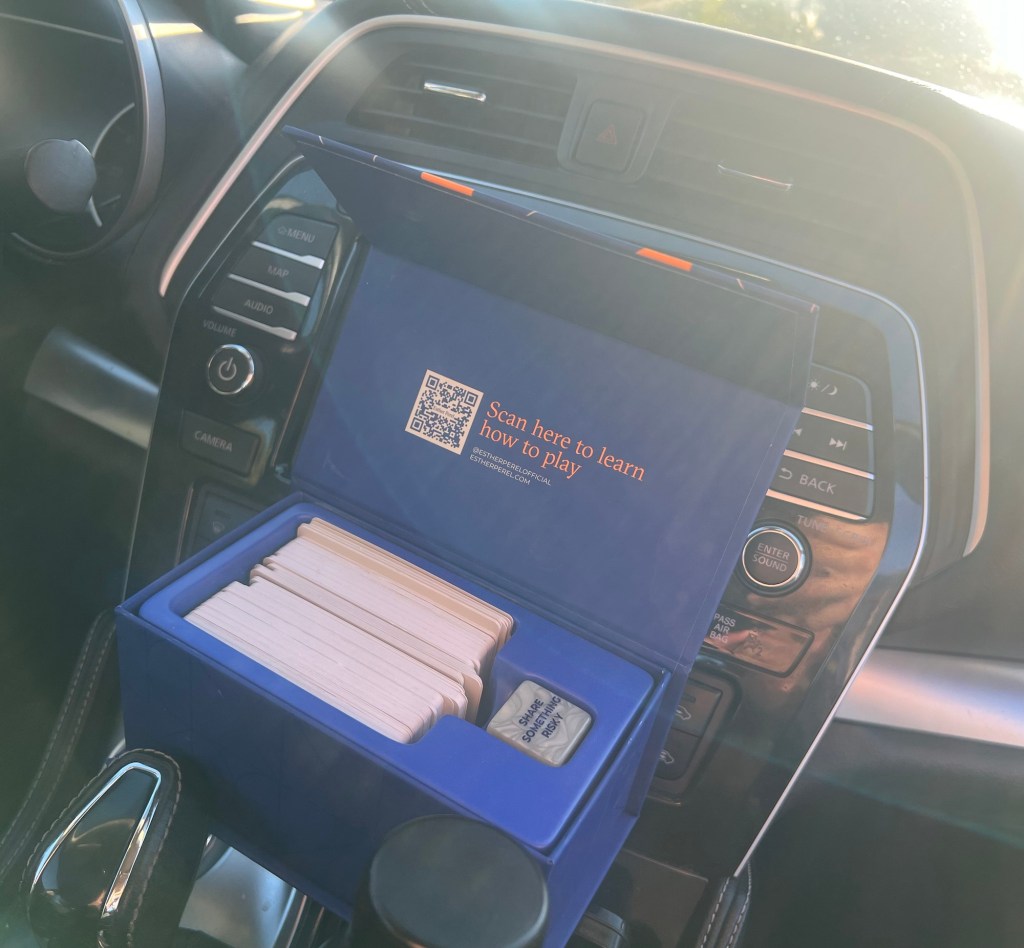
Available on Amazon.